Lomandra
BackLomandra, also known as mat rushes, are a range of tough clumping plants grown for their evergreen, grass-like foliage. There are about 50 species which are all native and can be found growing right across Australia. Lomandra are very versatile and look fabulous mass planted, as a low informal border, as individual accents in a mixed planting or even in pots. They are ideal for preventing erosion on embankments as they have a shallow, fibrous root system and are also a useful habitat plant to attract butterflies, lizards or frogs to your garden. What an awesome plant hey?
Grown primarily for their foliage lomandra do produce spikes of small cream to mustard-yellow flowers clustered along stems. These appear from spring through to summer and are often hidden within the foliage. On some plants they are more prominent and are especially beautiful when contrasting with the grey foliage varieties. Many lomandra flowers are deliciously scented but take care when trying to get a whiff as they’re quite spiky!
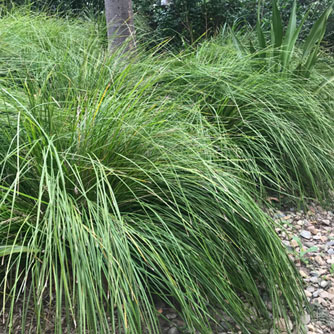
Lomandra always look great when massed planted
How To Grow Lomandra
Lomandras grow in full sun to part shade and most varieties are tolerant of most soil types. All will handle light to moderate frosts. With so many different lomandra available we’ve created a brief list of the more popular species and their main cultivars.
Lomandra hystrix grows in full sun to full shade. It tolerates intermittent water-logging, making these plants suitable for boggy areas and around (not in) ponds and watercourses. They are also extremely drought tolerant. Cultivars include:
- ‘Katie Belles’ – One of the most spectacular lomandras due to its masses of sweetly perfumed flowers and long arching leaves. Grows to 1.8m tall and 1.5m wide.
- ‘Tropic Belle’ – A more compact form growing to about 1m tall and wide. Although flower spikes sit within the foliage, they’re highly ornamental.
- ‘Lucky Stripe’ – Variegated foliage growing about 1m tall and wide.
Lomandra longifolia is the most widespread species and many local variants are cultivated. If possible seek these out as they’ll be particularly suitable for growing within your area. L. longifolia will also handle intermittent water-logging and conversely is drought tolerant. Cultivars include:
- ‘Tanika’ – Has bright green fine foliaged and forms compact clumps 50-60cm tall and 65cm wide.
- ‘Nyalla’ – Similar to ‘Tanika’ but with blue-grey foliage and slightly larger, forming clumps 75cm tall and wide.
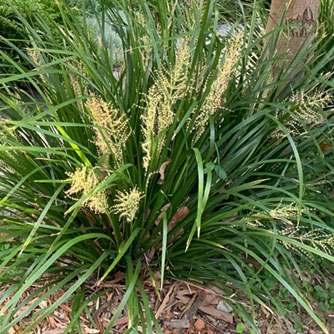
The unmissable flower spikes of lomandra 'Katie Belles' (image credit - Ozbreed)
Lomandra fluviatalis also tolerates moist conditions. Cultivars include:
- ‘Shara’ – Finely arching blue-grey foliage and long weeping flower spikes. 50cm tall and wide.
Lomandra cylindrica cultivars includes:
- ‘Lime Wave’ – Unusual, lime-green wispy foliage and vibrant yellow flowers. Requires good drainage. 70cm tall and wide.
Lomandra confertifolia requires well-drained soil and to be drier than other species. This is especially true for the grey foliaged forms. If you wish to grow L. confertifolia forms in clay soils apply gypsum before planting and plant into 5-10cm high mounds to assist with drainage. Cultivars include:
- ‘Mist’ – Fine, dark grey leaves growing 30-50cm tall and wide.
- ‘Misty Green’ – Fine, mid-green foliage forming a weeping clump 40-60cm tall and wide.
- ‘Seascape’ – Narrow, blue-grey leaves growing 50-60cm tall and wide with a weeping habit.
- ‘Little Con’ – A smaller-growing lomandra with narrow bright-green upright and weeping leaves. 30cm tall and wide.
- ‘Frosty Top’ – Grey-green arching foliage that complements the creamy-yellow flowers on purple-tinted stalks. 50cm tall and wide.
- ‘Little Pal’ – Bright green narrow foliage that is more upright than other confertifolia types. 70cm tall and 60cm wide.
While lomandras are usually available from regular garden centres it’s worth checking out your local indigenous nursery. There you’ll find some gems that aren’t always available in mainstream nurseries and will be particularly suitable for your climate and conditions.
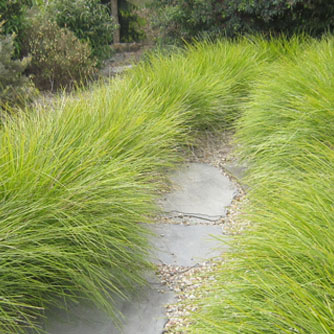
Lomandra 'Tanika' has lovely soft foliage (image credit - Ozbreed)
Fertilising and Maintaining Lomandra
To establish new plants and encourage growth in young plants apply OCP eco-seaweed and OCP eco-aminogro every 2-4 weeks throughout spring, summer and autumn. Once established, fertilise in spring with an organic pelletised fertiliser or layer of compost. Although lomandra are tough they will still benefit from an ongoing application of eco-seaweed every 2-4 weeks to keep them looking their best.
Newly planted lomandra require watering to help settle them in and start growing new roots. If the weather is hot and/or dry in the months following planting, water them every week to ensure they don’t dry out. Once established lomandra shouldn’t require much additional watering except during extended hot dry spells. Remember that grey foliaged forms won’t tolerate overwatering.
Dead leaves can build up over time in some varieties and may need removing if they eventually become unsightly. Rejuvenate old clumps that look poorly by pruning back to ground level (or even burning the whole plant) during autumn, winter or spring. After this severe prune apply OCP eco-seaweed and OCP eco-aminogro together and fresh new growth will soon appear. Avoid only pruning back to half the length of the foliage as the blunt ends will brown off and look unsightly. Dead flower spiks can be removed or left on the plant.
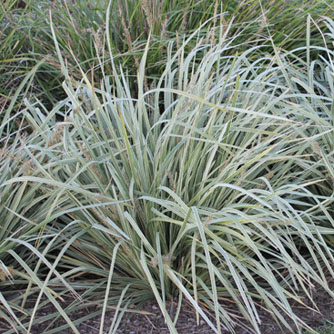
Variegated foliage of lomandra 'Lucky Stripe' (image credit - Ozbreed)
Dividing and Propagating Lomandra
Lomandra seeds (of straight species, not cultivars) germinate quite readily. Wait until the fruit matures and turns brown (the time of year will depend on your location), then sow lightly in potting mix, keeping it moist. They can take up to six weeks to germinate.
The easiest method of propagation however is to dig up a clump and divide it. Include enough roots (and rhizomes if there are any) to ensure the divided plant survives. Divide with secateurs and replant during autumn, winter (not in cold zones) and spring. Water new plants in with OCP eco-seaweed to reduce the shock and help new roots to form quickly.
Pests and Diseases of Lomandra
Lomandra generally don’t suffer from pests or diseases. Various species are a food source for butterfly species in the skipper family. This means you may notice female butterflies fluttering around ‘testing’ leaves for suitability to lay her eggs. Don’t be alarmed when you eventually notice the tiny caterpillars as they won’t decimate the plant and in a few months you’ll be rewarded with more butterflies in the garden.
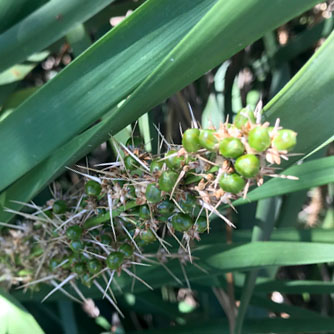
Ripening lomandra seed head


